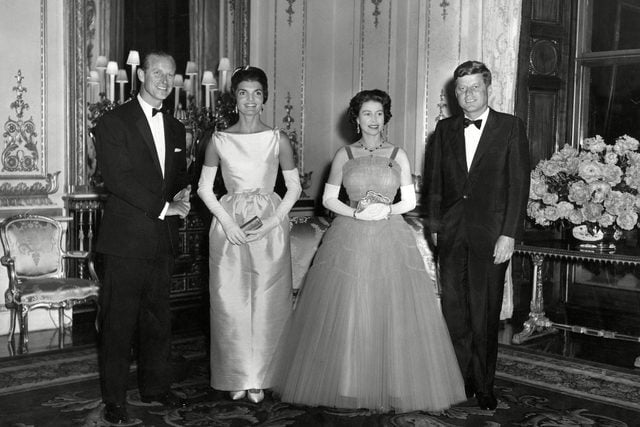What Really Happened When Jackie Kennedy Met Queen Elizabeth
Updated: Sep. 01, 2023
The first lady famously charmed France’s president Charles de Gaulle, but Britain’s sovereign was another matter. Here’s what didn’t make the history books.

Buckingham Palace, London
June 5, 1961
It is barely four months since President Kennedy’s inauguration. Mrs. Kennedy is still finding her feet.
Jackie is unsure of herself. In public, she smiles and waves. In private, she bites her nails and chain smokes. She is prone to self-pity. She is overheard saying, “Oh, Jack, I’m so sorry for you that I’m such a dud,” to which Kennedy replies, “I love you as you are.” Is each of them telling only half the truth?
Socially, she is an awkward mix of the gracious and the paranoid. “At one moment, she was misunderstood, frustrated, and helpless. The next moment, without any warning, she was the royal, loyal first lady to whom it was almost a duty to bow, to pay medieval obeisance,” is the way her English friend Robin Douglas-Home puts it. “Then again, without any warning, she was deflating someone with devastating barbs for being such a spaniel as to treat her as the first lady and deriding the pomp of politics, the snobbery of the social climber.”
But now, on their whistle-stop tour of Europe, Jackie suddenly appears formidable. The French take to her as one of their own: Born a Bouvier, she has French ancestry, and she spent a year at the Sorbonne. She speaks fluent French and has arrived with a wardrobe of clothes specially designed for her by Givenchy. At a banquet at Versailles, President de Gaulle greets her by saying, “This evening, Madame, you are looking like a Watteau.”
The political editor of Time reports that “thanks in large part to Jackie Kennedy at her prettiest, Kennedy charmed the old soldier into unprecedented flattering toasts and warm gestures of friendship.” At a press conference, President Kennedy says, “I do not think it altogether inappropriate to introduce myself … I am the man who accompanied Jacqueline Kennedy to Paris, and I have enjoyed it.”(Should you find yourself in the presence of the Queen, remember these royal etiquette tips.)
A few days later, after a stop in Vienna to see Soviet Premier Nikita Khrushchev, they attend the christening of Jackie’s niece Tina. From there, they go to an informal lunch with the prime minister and a number of friends and relations, including the Ormsby-Gores and the duke and duchess of Devonshire. The duchess, an old friend of the president, has mixed feelings about Jackie. “She is a queer fish. Her face is one of the oddest I ever saw. It is put together in a very wild way,” the duchess observes to her old friend Patrick Leigh Fermor.
That evening, the Kennedys attend a dinner at Buckingham Palace. It proves a minefield. The guest list has been the subject of negotiation: Traditionally, divorcées are not invited, so the queen has been reluctant to welcome Jackie’s sister Princess Lee Radziwill, who is on her second marriage, or her husband, Prince Stanislaw Radziwill, who is on his third. Under pressure, she relents, but, by way of retaliation, singularly fails to invite Princess Margaret or Princess Marina, both of whose names Jackie has put forward. Jackie’s old paranoia returns: She sees it as a plot to do her down. “The queen had her revenge,” she confides to Gore Vidal. “No Margaret, no Marina, no one except every Commonwealth minister of agriculture they could find.” Jackie also tells Vidal that she found the queen “pretty heavy going.” (When Vidal repeats this to Princess Margaret some years later, the princess loyally explains, “But that’s what she’s there for.”)
Over dinner, Jackie continues to feel awkward, even persecuted. “I think the queen resented me. Philip was nice, but nervous. One felt absolutely no relationship between them.”
The queen asks Jackie about her visit to Canada. Jackie tells her how exhausting she found being on public view for hours on end. “The queen looked rather conspiratorial and said, ‘One gets crafty after a while and learns how to save oneself.’ ” According to Vidal (who is prone to impose his own thoughts on others), Jackie considers this the only time the queen seems remotely human.
After dinner, the queen asks Jackie if she’d like to see “some pictures.” Yes, says Jackie, she certainly would. The queen takes her for a stroll down a long gallery in the palace. They stop in front of a Van Dyck. The queen says, “That’s a good horse.” Yes, agrees Jackie, that is a good horse. From Jackie’s account, this is the extent of their contact with one another, but others differ. Dinner at Buckingham Palace, writes Prime Minister Harold Macmillan in his diary that night, is “very pleasant.”
Nine months later, Jackie pays another visit to the queen at Buckingham Palace, this time by herself. She is more in the swing of things now. “I don’t think I should say anything about it except how grateful I am and how charming she was,” she tells the television cameras as she makes her escape.